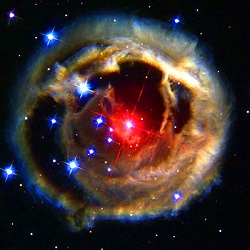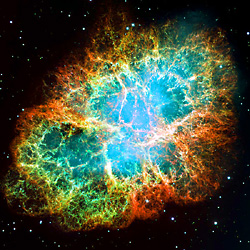
The official discord link if you wish to join the discord: https://discord.gg/j5RKwCvAFu
Support the wiki on our official Ko-Fi page or Patreon page!
Supernova: Difference between revisions
From The Codex
m |
|||
| Line 85: | Line 85: | ||
'''[[Tiering System]]:''' '''Varies''', normally '''High 5-B''' to '''Low 4-C''', '''Lower''' with Dwarf Nova | '''Varies''' | '''Varies''', normally '''5-A''' to '''4-C''' to '''High 4-C''' | '''Varies''' normally '''4-B''', '''Higher''' with Hypernova | '''[[Tiering System]]:''' '''Varies''', normally '''High 5-B''' to '''Low 4-C''', '''Lower''' with Dwarf Nova | '''Varies''' | '''Varies''', normally '''5-A''' to '''4-C''' to '''High 4-C''' | '''Varies''' normally '''4-B''', '''Higher''' with Hypernova | ||
'''[[Attack Potency]]:''' '''Varies''' (Novas vary depending on the star and white dwarf), normally '''Large Planet level''' ([https://astronomy.swin.edu.au/cosmos/C/Classical+Novae#:~:text=This%20is%20reflected%20in%20the%20amount%20of%20energy%20released%20in%20the%20explosions%2C%20with%20classical%20novae%20releasing%20around%201037%20Joules Novas can emit about 10<sup>-7</sup> Foe or about 10<sup>37</sup> joules]) to '''Low Mass Star level''' ([https://svs.gsfc.nasa.gov/11608/#:~:text=Each%20nova%20releases%20up%20to,far%20more%20powerful%20cosmic%20blasts. Each nova releases up to 100,000 times the annual energy output of our sun], [https://howthingsfly.si.edu/ask-an-explainer/how-much-heat-does-sun-produce-year-0#:~:text=The%20sun%20produces%201.23%20x,felt%20150%20million%20kilometers%20away. with the sun producing 1.23x10<sup>35</sup> joules of energy in one year](1.23e40 Joules)), '''Lower''' with Dwarf Nova ([https://www.projectrho.com/public_html/rocket/apocalypse.php#id--Assorted_Apocalypses--Exploding_Stars--Nova:~:text=This%20only%20releases%20a%20tiny%20fraction%20of%20the%20energy%20of%20a%20full%20fledged%20nova%2C%20and%20would%20be%20difficult%20to%20detect%20from%20another%20solar%20system%20without%20a%20telescope.%20It%20is%20hardly%20apocalyptic. Dwarf Novas release a tiny fraction of energy of a full-fledged nova]) | '''Varies''' (Luminous Red Nova's carry luminosities between that of a nova and that of a supernova) | '''Varies''' ([https://www.nasa.gov/news-release/nasas-hubble-finds-telltale-fireball-after-gamma-ray-burst/ Kilonovas are caused from compact objects crashing together]), normally '''Brown Dwarf level''' ([https://www.nasa.gov/news-release/nasas-hubble-finds-telltale-fireball-after-gamma-ray-burst/ Kilonovas are about 1000 times brighter than a nova](1e40 Joules)) to '''Star level''' to '''High Mass Star level''' ([https://www.nasa.gov/news-release/nasas-hubble-finds-telltale-fireball-after-gamma-ray-burst/ Kilonovas are also about 1/10th to 1/100th the brightness of a typical supernova](1e42 to 1e44 Joules)) | '''Varies''', normally '''Solar System | '''[[Attack Potency]]:''' '''Varies''' (Novas vary depending on the star and white dwarf), normally '''Large Planet level''' ([https://astronomy.swin.edu.au/cosmos/C/Classical+Novae#:~:text=This%20is%20reflected%20in%20the%20amount%20of%20energy%20released%20in%20the%20explosions%2C%20with%20classical%20novae%20releasing%20around%201037%20Joules Novas can emit about 10<sup>-7</sup> Foe or about 10<sup>37</sup> joules]) to '''Low Mass Star level''' ([https://svs.gsfc.nasa.gov/11608/#:~:text=Each%20nova%20releases%20up%20to,far%20more%20powerful%20cosmic%20blasts. Each nova releases up to 100,000 times the annual energy output of our sun], [https://howthingsfly.si.edu/ask-an-explainer/how-much-heat-does-sun-produce-year-0#:~:text=The%20sun%20produces%201.23%20x,felt%20150%20million%20kilometers%20away. with the sun producing 1.23x10<sup>35</sup> joules of energy in one year](1.23e40 Joules)), '''Lower''' with Dwarf Nova ([https://www.projectrho.com/public_html/rocket/apocalypse.php#id--Assorted_Apocalypses--Exploding_Stars--Nova:~:text=This%20only%20releases%20a%20tiny%20fraction%20of%20the%20energy%20of%20a%20full%20fledged%20nova%2C%20and%20would%20be%20difficult%20to%20detect%20from%20another%20solar%20system%20without%20a%20telescope.%20It%20is%20hardly%20apocalyptic. Dwarf Novas release a tiny fraction of energy of a full-fledged nova]) | '''Varies''' (Luminous Red Nova's carry luminosities between that of a nova and that of a supernova) | '''Varies''' ([https://www.nasa.gov/news-release/nasas-hubble-finds-telltale-fireball-after-gamma-ray-burst/ Kilonovas are caused from compact objects crashing together]), normally '''Brown Dwarf level''' ([https://www.nasa.gov/news-release/nasas-hubble-finds-telltale-fireball-after-gamma-ray-burst/ Kilonovas are about 1000 times brighter than a nova](1e40 Joules)) to '''Star level''' to '''High Mass Star level''' ([https://www.nasa.gov/news-release/nasas-hubble-finds-telltale-fireball-after-gamma-ray-burst/ Kilonovas are also about 1/10th to 1/100th the brightness of a typical supernova](1e42 to 1e44 Joules)) | '''Varies''', normally '''Solar System level''' ([https://astronomy.swin.edu.au/cosmos/C/Classical+Novae#:~:text=In%20a%20Type%20Ia%20supernova%2C%20the%20thermonuclear%20runaway%20occurs%20within%20white%20dwarf%20itself%2C%20completely%20disrupting%20the%20progenitor.%20This%20is%20reflected%20in%20the%20amount%20of%20energy%20released%20in%20the%20explosions%2C%20with%20classical%20novae%20releasing%20around%201037%20Joules%2C%20and%20Type%20Ia%20supernovae%20~1044Joules. Supernova explosions release energies of about 10<sup>44</sup> joules], [https://ui.adsabs.harvard.edu/abs/1977Icar...30..447C/abstract the supernova is the event that helped determine the composition of the Solar System 4.5 billion years ago], [https://www.sciencedirect.com/science/article/abs/pii/0019103577901014?via%3Dihub and may even have triggered the formation of this system]), '''Higher''' with Hypernova ([https://people.umass.edu/wqd/hnr/faq.htm#:~:text=How%20much%20energy%20does%20a,100%20greater%20than%20a%20supernova. Hypernovas release about 10^53 ergs or around 9.99e45 joules]) | ||
'''[[Speed|Attack Speed]]:''' '''Relativistic''' core collapse ([https://phys.org/news/2015-04-quickly-supernova.html#:~:text=and%20boom%2C%20supernova.,shockwave%20of%20matter%20propagating%20outward. Novas collapse inward at 70,000 kilometers per second or about 23% the speed of light]<ref>Note: The link itself mistakenly says 70,000 meters per second rather then 70,000 kilometers per second, we know it's kilometers as it rates the percentage of the speed of light it's going, which matches with what 70,000 km/s would be</ref>), '''Relativistic+''' with Gamma Ray Burst ([https://svs.gsfc.nasa.gov/11608/#:~:text=Each%20nova%20releases%20up%20to,far%20more%20powerful%20cosmic%20blasts. Novas release a gamma ray], [https://en.wikipedia.org/wiki/GRB_080916C resulting in a minimum velocity of approximately 299,792,158 m/s (99.9999% the speed of light)] [https://science.nasa.gov/universe/gamma-ray-bursts-harvesting-knowledge-from-the-universes-most-powerful-explosions/ being described as a particles accelerating near the speed of light]), '''Speed of Light''' with Gravitational Waves ([https://aasnova.org/2019/07/05/can-we-detect-gravitational-waves-from-core-collapse-supernovae/ Core collapsing causes gravitational waves] [https://spaceplace.nasa.gov/gravitational-waves/en/#:~:text=Gravitational%20waves%20are%20invisible.,path%20as%20they%20pass%20by. which travel at the speed of light]) | '''[[Speed|Attack Speed]]:''' '''Relativistic''' core collapse ([https://phys.org/news/2015-04-quickly-supernova.html#:~:text=and%20boom%2C%20supernova.,shockwave%20of%20matter%20propagating%20outward. Novas collapse inward at 70,000 kilometers per second or about 23% the speed of light]<ref>Note: The link itself mistakenly says 70,000 meters per second rather then 70,000 kilometers per second, we know it's kilometers as it rates the percentage of the speed of light it's going, which matches with what 70,000 km/s would be</ref>), '''Relativistic+''' with Gamma Ray Burst ([https://svs.gsfc.nasa.gov/11608/#:~:text=Each%20nova%20releases%20up%20to,far%20more%20powerful%20cosmic%20blasts. Novas release a gamma ray], [https://en.wikipedia.org/wiki/GRB_080916C resulting in a minimum velocity of approximately 299,792,158 m/s (99.9999% the speed of light)] [https://science.nasa.gov/universe/gamma-ray-bursts-harvesting-knowledge-from-the-universes-most-powerful-explosions/ being described as a particles accelerating near the speed of light]), '''Speed of Light''' with Gravitational Waves ([https://aasnova.org/2019/07/05/can-we-detect-gravitational-waves-from-core-collapse-supernovae/ Core collapsing causes gravitational waves] [https://spaceplace.nasa.gov/gravitational-waves/en/#:~:text=Gravitational%20waves%20are%20invisible.,path%20as%20they%20pass%20by. which travel at the speed of light]) | ||
Latest revision as of 23:55, 14 November 2024
Background
A nova is a transient astronomical event that causes the sudden appearance of a bright, apparently "new" star that slowly fades over weeks or months.
Back in the 1950's all the science fiction novels which needed an earth-shattering kaboom would use a Nova. Star goes boom, incinerates the entire solar system, pretty apocalyptic. Astronomers didn't know anything about novae except they were huge, so science fiction author had free reign.
Nowadays we know that novae happen only in binary star systems. A normal star has the misfortune to be orbited by a white dwarf. Over the millennium the dwarf sucks hydrogen out of the normal star like a cosmic vampire. The dwarf starts burning the hydrogen using carbon-nitrogen-oxygen fusion reaction.
Sometimes the the white dwarf suffers a runaway reaction, and you get a nova.
The fact that a white dwarf is required made instantly obsolete all those science fiction stories about the sun going nova.
With each explosion only about one ten-thousandth of the white dwarf's mass is ejected. The point is that a vampire white dwarf can go nova multiple times. For instance, the star RS Ophiuchi has gone nova six times. The mass is ejected at velocities up to several thousand kilometers per second.
Astronomers estimate that about 30 to 60 novae occur in our galaxy per year.
A nova can reach an absolute magnitude of -8.8, or about 42.7 trillion times the luminosity of the sun. Nova emit about 10-7 Foe or about 1037 joules.
Novae to eject enriched elements into the interstellar medium like red giant, supergiant stars, and supernovae do. But only a paltry amount. Supernovae emit 50 times as much, and red giant/supergiant stars emit 200 times as much.General Information
Name: Nova, Novae, Novas
Other Names: Dwarf Nova, Luminous Red Nova, Kilonova, Supernova, Hypernova
Origin: Real World
Appearance:
- Nova: Typically around 35 to 75 per year within the Milky Way Galaxy.
- Dwarf Nova: No found official recorded amount, though they normally appear within the Milky Way Galaxy.
- Luminous Red Nova: The Large Synoptic Survey Telescope repotedly observes 20-750 luminous red novaes per year.
- Kilonova: Extremely rare, with it being believed that only 10 such systems can have an event like this occur in the entire Milky Way Galaxy.
- Supernova: Typically once every 50 years in the Milky Way Galaxy.
- Hypernova: The data is harder to find on this as a hypernova is a massively amplified supernova, thus the supernovas observed can at times be hypernovas.
Classification: Stellar Explosions, Cataclysmic Variable
Environment: Outer Space
Result: Massive amount of luminosity energy that can be seen from telescopes, can also at times result in black holes.
Codex Statistics
Key: Nova | Luminous Red Nova | Kilonova | Supernova
Tiering System: Varies, normally High 5-B to Low 4-C, Lower with Dwarf Nova | Varies | Varies, normally 5-A to 4-C to High 4-C | Varies normally 4-B, Higher with Hypernova
Attack Potency: Varies (Novas vary depending on the star and white dwarf), normally Large Planet level (Novas can emit about 10-7 Foe or about 1037 joules) to Low Mass Star level (Each nova releases up to 100,000 times the annual energy output of our sun, with the sun producing 1.23x1035 joules of energy in one year(1.23e40 Joules)), Lower with Dwarf Nova (Dwarf Novas release a tiny fraction of energy of a full-fledged nova) | Varies (Luminous Red Nova's carry luminosities between that of a nova and that of a supernova) | Varies (Kilonovas are caused from compact objects crashing together), normally Brown Dwarf level (Kilonovas are about 1000 times brighter than a nova(1e40 Joules)) to Star level to High Mass Star level (Kilonovas are also about 1/10th to 1/100th the brightness of a typical supernova(1e42 to 1e44 Joules)) | Varies, normally Solar System level (Supernova explosions release energies of about 1044 joules, the supernova is the event that helped determine the composition of the Solar System 4.5 billion years ago, and may even have triggered the formation of this system), Higher with Hypernova (Hypernovas release about 10^53 ergs or around 9.99e45 joules)
Attack Speed: Relativistic core collapse (Novas collapse inward at 70,000 kilometers per second or about 23% the speed of light[1]), Relativistic+ with Gamma Ray Burst (Novas release a gamma ray, resulting in a minimum velocity of approximately 299,792,158 m/s (99.9999% the speed of light) being described as a particles accelerating near the speed of light), Speed of Light with Gravitational Waves (Core collapsing causes gravitational waves which travel at the speed of light)
Range: Varies, normally at least Stellar for typical nova explosions (Nova explosions normally produce so much light, they can be seen from distant solar systems without a telescope and can be seen from other galaxies), Interplanetary with Supernovas (The supernova is the event that helped determine the composition of the Solar System 4.5 billion years ago, and may even have triggered the formation of this system), Lower with Dwarf Novas (Dwarf Novas are difficult to detect from another solar system without a telescope)
Powers and Techniques
References
- ↑ Note: The link itself mistakenly says 70,000 meters per second rather then 70,000 kilometers per second, we know it's kilometers as it rates the percentage of the speed of light it's going, which matches with what 70,000 km/s would be




